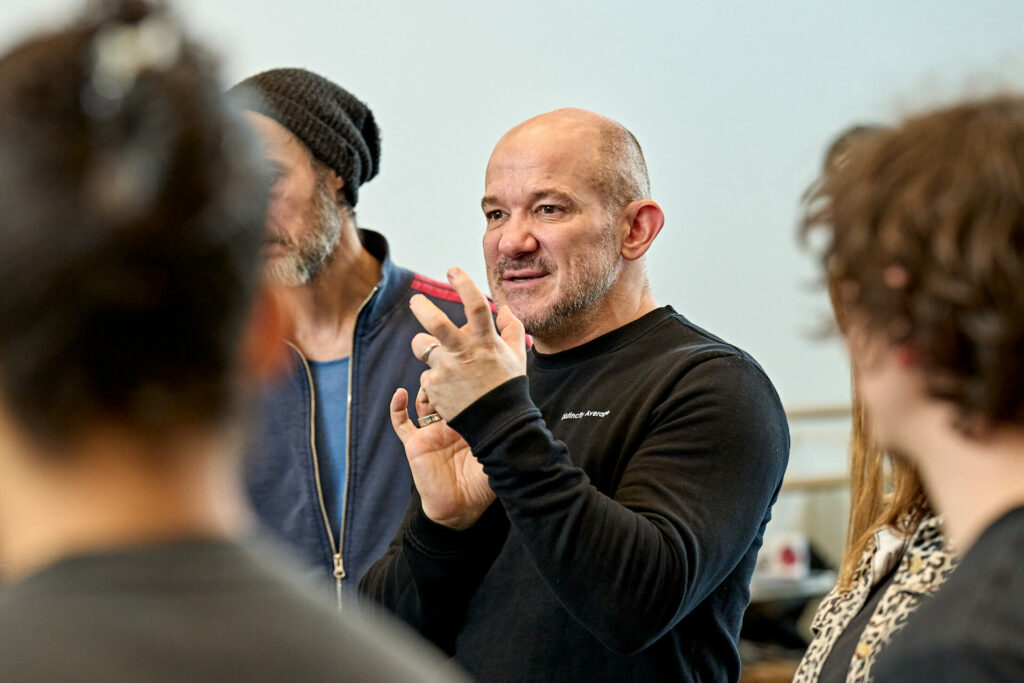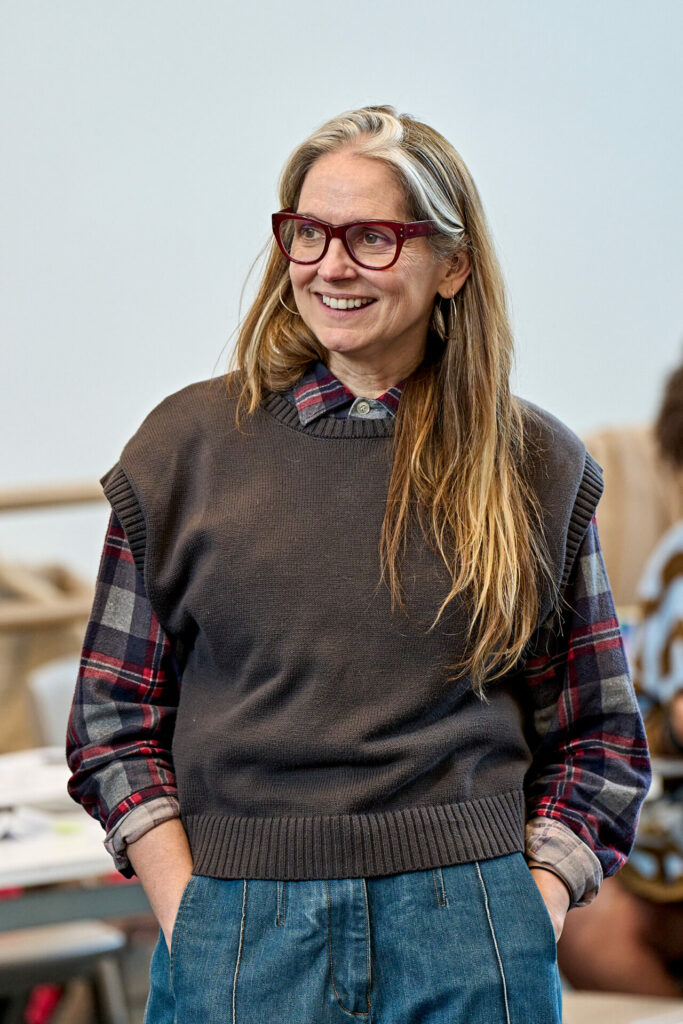Radiohead’s Thom Yorke and the creative team behind ‘Hamlet: Hail to the Thief’ tell us how they brought the show to life
As Thom Yorke prepares to debut his very unique take on Shakespeare, the Radiohead icon and the show's creative team tell Rolling Stone UK how they tackled this very unique project.
By Kate Wyver

Thom Yorke thought it was madness. “I never associated music favourably with Shakespeare,’ says the Radiohead frontman. ‘I saw his work as something totemic, so applying our music to it initially seemed a kind of sacrilege.” He adjusts his thick black glasses and lets slip a small grin. “But I’m always up for a little bit of sacrilege.”
In October 2003, director and designer Christine Jones was at Madison Square Garden as Radiohead played the new tracks of their soon-to-be Grammy Award-winning album, Hail to the Thief. The heady, propulsive songs were still circling her mind a few months later as she was designing a production of Hamlet. The album had not been intentionally influenced by the play, but uncanny similarities between them began to appear to Jones. “I was haunted by this idea of them being in dialogue with each other,” she says, describing the echoes between them like ghost sightings. “Both look at the complexity of what it is to be human, to delude yourself and to be deluded by your government. To find your moral compass within the world.” She started to imagine a production where their dark, teetering interrogations of distrust and paranoia, lined by glimmers of tenderness, could collide.
When Jones suggested the idea to Yorke, he couldn’t stop thinking about it. “That’s how I judge things a lot,” says Yorke, tapping his forehead, “if they stick in here.” He read that Shakespeare would commission leading composers of the day to write songs and he would collaborate with them. “They weren’t just ditties,” Yorke says, “they were structural parts of his work.” Perhaps the suggestion for this cross-form production is not so radical after all; the creative team are simply responding to an invitation offered 400 years earlier.

Led by her gut, Jones cut the text down from a four-hour epic to something taking the shape of roughly 90 minutes. Beginning to experiment with layering music underneath the edited text, Yorke quickly saw that it wouldn’t work to play the songs in the order of the track list – or to play the complete songs at all. “It’s very much broken down, shattered pieces of glass,” he explains, “glued back together.” Radiohead made the original album quickly, and Yorke always felt it was “the record that got away.” This, his first foray into theatre, has given him a chance to revisit it for a new purpose.
As movement and music started to come to the forefront of the story, the team kept shedding layers of the text. “What can we show, what can we hear, instead of having to say it all?” Jones asks. “Distillation in service of illumination.”
Unlocking a different kind of language is Steven Hoggett, co-director and Jones’ frequent collaborator. Co-founder of acclaimed physical theatre company Frantic Assembly, his vocabulary is one of muscle, skin and bone. “When I met Steven,” Jones says, “I felt this was the person I came to New York to find.” They were fuelled by working together on productions including American Idiot, Let the Right One In, and Harry Potter and the Cursed Child. When Jones asked Hoggett to come on board for this project, he went back to listen to how the album suggested itself for the text. “It was thrilling to feel there was something happening already and we didn’t have to approach it with a crowbar,” he says. “We just had to give it a nudge.”

How do you dance to Radiohead? “I’ve never known that,” Yorke muses. “Movement only came when I was able to put a guitar down, and –,” he grapples for words, “you just start doing things.” Yorke’s actions on stage are instinctive; Hoggett’s process is similarly so. “You look for the emotional register,” the co-director says, describing the way the company devises together. “We’re not telling the actors to physicalise ‘to be or not to be’. That’s never going to work.” Instead, he and choreographer Jess Williams set tasks in the rehearsal room. “What is it to drive towards someone with a fury? What if you’re hiding something? When are you internally true and when are you externally playing a game?” They try to be sly in their direction. “We build the architecture of the movement and then we chip away at it,” he says. “Otherwise you just end up driving towards the middle eight.”
The whole production flinches from neatness. Yorke wants to avoid the music seeming overly illustrative, “in the sense that a musician draws lines that follow the emotional path of what’s happening.” He believes that does a disservice to both text and music. “I want them to rub up against each other,” he says of the two source materials, “to uproot each other. There should be tension between them.” This agitation seeps through the entire play; examining the kind of internal distress that makes too-solid flesh crawl, the team have been looking at Robert Longo’s writhing drawings and Egon Schiele’s contorted paintings.”They’re people trying to hide but their bodies betray them,” Jones says. That’s what the team is seeking through movement: a feeling of bodies being hijacked by music.

Sitting somewhere between a recording studio, a sound testing chamber and an interrogation room, the set echoes this feeling of unease, solidifying the sense of being observed and overheard. “We’re not trying to overtly comment on the world right now,” Jones says firmly, noting the lack of a specific time and place. The reverberations with present day are implicit. More so now than when the process began, and they are wary of putting anything too prescriptive in the way of the story. “Despite having called a record Hail to the Thief,” Yorke concedes, the words nabbed from the news during anti-Bush protests, “I think it’s a death knell for any piece of work to be described as ‘political’ and then be cornered forevermore having to contextualise that.” Like the idea of this collaboration, the phrase would simply not leave him be. “I was at its mercy.” Rather than dictate its intentions, they want the production to pose questions. “What’s my place in the world?” Jones considers. “How do I try to understand things through poetry, philosophy, music? Who’s there?”
Twenty years in the making, Hamlet Hail to the Thief is a strange, high-wire experiment. “There was a moment,” Hoggett says with a puff of laughter, “when I realised how many bad versions there are of someone who isn’t Thom singing a Radiohead song.” It wasn’t until they got into the rehearsal room with the band that he could let go of that fear. “Everything started to become possible.” This sense of raw potential drives their continual discovery. “I feel most undone when theatre is unbridled and you don’t know what’s going to happen next,” says Jones. “When we taste that in rehearsal, I feel giddy with anticipation of what we might find.”
Originally commissioned for the Hamlet Hail to the Thief programme. Kate Wyver is a theatre critic and features writer based in London.
